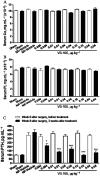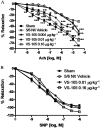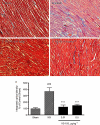VS-105: a novel vitamin D receptor modulator with cardiovascular protective effects
- PMID: 21557735
- PMCID: PMC3188908
- DOI: 10.1111/j.1476-5381.2011.01473.x
VS-105: a novel vitamin D receptor modulator with cardiovascular protective effects
Abstract
Background and purpose: Vitamin D receptor (VDR) modulators (VDRMs) such as calcitriol, paricalcitol and doxercalciferol are commonly used to manage hyperparathyroidism secondary to chronic kidney disease (CKD). CKD patients experience extremely high risks of cardiovascular morbidity and mortality. Clinical observations show that VDRM therapy may be associated with cardio-renal protective and survival benefits for CKD patients. However, hypercalcaemia remains a serious side effect for current VDRMs, which leads to the need for frequent dose titration and serum Ca (calcium) monitoring. Significant clinical benefits can be derived from a VDRM with cardiovascular protective effects without the hypercalcaemic liability.
Experimental approach: Male Sprague-Dawley rats were 5/6 nephrectomized and 6 weeks later, after they had established uraemia, elevated parathyroid hormone levels, endothelial dysfunction and left ventricular hypertrophy, the rats were treated with VS-105, a novel VDRM. The effects of VS-105 were also tested in cultured HL-60 cells.
Key results: VS-105 induced HL-60 cell differentiation with an EC₅₀ value at 11.8 nM. Treatment (i.p., 3× a week over a period of 2 weeks) of the 5/6 nephrectomized rats by VS-105 (0.004-0.64 µg·kg⁻¹) effectively suppressed serum parathyroid hormone without raising serum Ca or phosphate levels. Furthermore, 2 weeks of treatment with VS-105 improved endothelium-dependent aortic relaxation and attenuated left ventricular abnormalities in a dose range that did not affect serum Ca levels. Similar results were obtained when VS-105 was administered i.p. or by oral gavage.
Conclusions and implications: VS-105 exhibits an overall therapeutic product profile that supports expanded use in CKD to realize the cardiovascular protective effects of VDR activation.
© 2011 Vidasym. British Journal of Pharmacology © 2011 The British Pharmacological Society.
Figures









Similar articles
-
Vitamin D receptor agonist VS-105 improves cardiac function in the presence of enalapril in 5/6 nephrectomized rats.Am J Physiol Renal Physiol. 2015 Feb 15;308(4):F309-19. doi: 10.1152/ajprenal.00129.2014. Epub 2014 Dec 10. Am J Physiol Renal Physiol. 2015. PMID: 25503724 Free PMC article.
-
Two novel vitamin D receptor modulators with similar structures exhibit different hypercalcemic effects in 5/6 nephrectomized uremic rats.Am J Nephrol. 2013;37(4):310-9. doi: 10.1159/000348755. Epub 2013 Mar 20. Am J Nephrol. 2013. PMID: 23548814
-
Cardiac effect of vitamin D receptor modulators in uremic rats.J Steroid Biochem Mol Biol. 2016 Oct;163:20-7. doi: 10.1016/j.jsbmb.2016.03.028. Epub 2016 Apr 9. J Steroid Biochem Mol Biol. 2016. PMID: 27072785
-
1alpha(OH)D3 One-alpha-hydroxy-cholecalciferol--an active vitamin D analog. Clinical studies on prophylaxis and treatment of secondary hyperparathyroidism in uremic patients on chronic dialysis.Dan Med Bull. 2008 Nov;55(4):186-210. Dan Med Bull. 2008. PMID: 19232159 Review.
-
Different vitamin D receptor agonists exhibit differential effects on endothelial function and aortic gene expression in 5/6 nephrectomized rats.J Steroid Biochem Mol Biol. 2015 Apr;148:202-9. doi: 10.1016/j.jsbmb.2014.12.002. Epub 2014 Dec 10. J Steroid Biochem Mol Biol. 2015. PMID: 25500070 Review.
Cited by
-
Vitamin D receptor agonist VS-105 improves cardiac function in the presence of enalapril in 5/6 nephrectomized rats.Am J Physiol Renal Physiol. 2015 Feb 15;308(4):F309-19. doi: 10.1152/ajprenal.00129.2014. Epub 2014 Dec 10. Am J Physiol Renal Physiol. 2015. PMID: 25503724 Free PMC article.
-
Ergocalciferol improves endothelial vasodilatory and vasoconstrictor function in an in vivo model of mild uraemia.Biosci Rep. 2019 Dec 20;39(12):BSR20190711. doi: 10.1042/BSR20190711. Biosci Rep. 2019. PMID: 31789348 Free PMC article.
-
VS-501: A NOVEL, NON-ABSORBED, CALCIUM- AND ALUMINUM-FREE, HIGHLY EFFECTIVE PHOSPHATE BINDER DERIVED FROM NATURAL PLANT POLYMER.Pharmacol Res Perspect. 2014 Jun 1;2(3):e00042. doi: 10.1002/prp2.42. Pharmacol Res Perspect. 2014. PMID: 25197556 Free PMC article.
-
Preclinical studies of VS-505: a non-absorbable highly effective phosphate binder.Br J Pharmacol. 2016 Jul;173(14):2278-89. doi: 10.1111/bph.13510. Epub 2016 Jun 12. Br J Pharmacol. 2016. PMID: 27156057 Free PMC article.
References
-
- Agarwal R, Acharya M, Tian J, Hippensteel RL, Melnick JZ, Qiu P, et al. Antiproteinuric effect of oral paricalcitol in chronic kidney disease. Kidney Int. 2005;68:2823–2828. - PubMed
-
- Alborzi P, Patel NA, Peterson C, Bills JE, Bekele DM, Bunaye Z, et al. Paricalcitol reduces albuminuria and inflammation in chronic kidney disease: a randomized double-blind pilot trial. Hypertension. 2008;52:249–255. - PubMed
-
- Baigent C, Burbury K, Wheeler D. Premature cardiovascular disease in chronic renal failure. Lancet. 2000;356:147–152. - PubMed
-
- Biggar PH, Liangos O, Fey H, Brandenburg VM, Ketteler M. Vitamin D, chronic kidney disease and survival: a pluripotent hormone or just another bone drug? Pediatr Nephrol. 2011;26:7–18. - PubMed
Publication types
MeSH terms
Substances
LinkOut - more resources
Full Text Sources
Other Literature Sources

